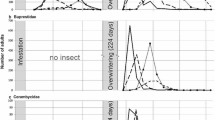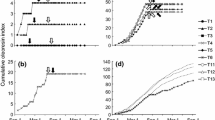Abstract
Pine wilt disease is caused by the pine wood nematode [Bursaphelenchus xylophilus (Steiner et Buhrer) Nickle]. In East Asia, an important vector of the nematode is Monochamus alternatus Hope. We determined the tolerance and reproductive ability of sawyer beetles and the nematode to altitude and temperature at elevations between 850 and 1,450 m on Mt. Fuji in Japan. The number of emergent adults decreased markedly along the altitudinal gradient, but the beetle could still reproduce at 1,050 m (8.2 °C annual mean temperature). Beetles with a 2-year life cycle increased rapidly in number with increasing altitude. The pine wood nematode survived through winter at all altitudes tested (850–1,450 m). The beetle population decreased between 950 (9.1 °C) and 1,150 m (8.3 °C). Therefore, the beetle population seems to be stable at 850 m (10.2 °C) and lower altitudes (higher temperatures) but cannot be maintained from 950 (9.1 °C) to 1,150 m (8.3 °C) without constant immigration of beetles from lower altitudes. The beetles could not reproduce at altitudes above 1,150 m (lower than 8.2 °C). From the mean and effective cumulative temperatures, we concluded that the beetle (and its population) can endure temperatures lower than those previously reported. Pine wilt disease also occurred at lower temperatures and higher altitudes than expected. We have summarized the principal strategies for controlling the disease at high altitudes based on these results.





Similar content being viewed by others
References
(Japanese titles were translated into English by the authors)
Baba K (1985) Pine wilt disease and its control in Yamanashi prefecture. For Pests 34:206–208 (in Japanese)
Cheng H, Lin M, Li W, Fang Z (1983) The occurrence of a pine wilting disease caused by a nematode found in Nanjing. For Pest Dis 4:1–5 (in Chinese)
de Guiran G, Bruguier N (1989) Hybridization and phylogeny of the pine wood nematode (Bursaphelenchus spp.). Nematologica 35:321–330
Enda N (1976) Life cycle of Monochamus alternatus. For Pest 25:182–185
Futai K (2008) Pine wilt in Japan: from first incidence to the present. In: Zhao BG, Futai K, Sutherland JR, Takeuchi Y (eds) Pine wilt disease. Springer, Tokyo, pp 5–12
Hashimoto H, Kiyohara T, Dozono Y, Takizawa Y, Miyazaki T, Kawabata K, Katsu Y, Taniguchi A (1974) Relationships between altitudinal distribution of Monochamus alternatus and Bursaphelenchus xylophilus and damage inflicted. Trans Jpn For Soc 85:253–256 (in Japanese)
Ido N, Takeda T (1975) A few findings on oviposition and the life span of Monochamus alternatus in breeding. Trans Jpn For Soc 86:337–338 (in Japanese)
Iwasaki A, Morimoto K (1973) Study on Monochamus alternatus (I)—period from emergence to feeding on pine trees. Trans Meet Kyushu Br Jpn For Soc 26:205 (in Japanese)
Jinno Y, Takizawa Y, Sato H (1987) Characteristics and control of pine wilt disease in cool or high regions. Forest research expository series 86, Forestry Science and Technology Institute, Tokyo (in Japanese)
Kamotani T (1980) Monochamus alternatus in Akita prefecture—time of eclosion and emergence, period of food tree supply, and biennial emergence. Trans Meet Tohoku Br Jpn For Soc 32:203–205 (in Japanese)
Kamata N (2008) Integrated pest management of pine wilt disease in Japan: tactics and strategies. In: Zhao BG, Futai K, Sutherland JR, Takeuchi Y (eds) Pine wilt disease. Springer, Tokyo, pp 304–322
Kishi Y (1977) The number of the generations of Monochamus alternatus in Ibaraki prefecture. For Pests 26:97–98 (in Japanese)
Kishi Y (1995) The pine wood nematode and the Japanese pine sawyer. Thomas Company Ltd., Tokyo
Kiyohara T, Tokushige Y (1971) Inoculation experiments of a nematode, Bursaphelenchus sp., onto pine trees. J Jpn For Soc 53:210–218 (in Japanese with English abstract)
Kiyohara T, Hashimoto H, Douzono Y, Ono K (1975) Vertical distribution of Bursaphelenchus xylophilus—Mt. Unzen, Aso-Kokonoe mountain range. Trans Meet Kyushu Br Jpn For Soc 26:193–194 (in Japanese)
Kobayashi I (1979) Abnormal weather for 2 years and damage caused by pine wilt disease in Western Japan. For Pests 28:80–84 (in Japanese)
Mamiya Y (1975) Efficiency of the Baermann method of extracting Bursaphelenchus xylophilus. For Pests 24:115–119 (in Japanese)
Mamiya Y, Enda N (1972) Transmission of Bursaphelenchus lignicolus (Nematoda: Aphelenchoididae) by Monochamus alternatus (Coleoptera: Cerambycidae). Nematologica 18:159–162
Morimoto K, Iwasaki A (1972) Role of Monochamus alternatus (Coleoptera: Cerambycidae) as a vector of Bursaphelenchus lignicolus (Nematoda: Aphelenchoididae). J Jpn For Soc 54:177–183 (in Japanese with English abstract)
Mota MM, Braasch H, Bravo MA, Penas AC, Burgermeister W, Metge K, Sousa E (1999) First report of Bursaphelenchus xylophilus in Portugal and in Europe. Nematology 1:727–734
Nakamura K, Noguchi E. (2006) Estimating the distribution of naturally suppressed area of pine wilt disease epidemic using a thermal index. Trans Jpn For Soc 117:PF16 (in Japanese)
Nakane I (1975) The state of twice-wintering larvae and Bursaphelenchus xylophilus they carry. Trans Meet Kansai Br Jpn For Soc 27:252–254 (in Japanese)
Ogawa S, Hagiwara Y (1980) Expansion of damage caused by pine wilt disease. For Pests 29:115–117 (in Japanese)
Ohtsuka T, Goto T, Sugita M, Nakashima T, Ikeguchi H (2003) The origin of pine forest on Ken-Marubi lava flow on the lower slopes of Mt. Fuji. Veg Sci 20:43–54 (in Japanese with English abstract)
Robertson L, Cobacho Arcos S, Escuer M, Santiago Merino R, Esparrago G, Abelleira A, Navas A (2011) Incidence of the pinewood nematode Bursaphelenchus xylophilus Steiner & Buhrer, 1934 (Nickle, 1970) in Spain. Nematology 13:755–757
Rutherford TA, Webster JM (1987) Distribution of pine wilt disease with respect to temperature in North America, Japan, and Europe. Can J For Res 17:1050–1059
Saito A (1985) Biennial and triennial emergences of Monochamus alternatus and the number of Bursaphelenchus xylophilus they carry. Trans Meet Tohoku Br Jpn For Soc 37:258–259 (in Japanese)
Shin SC (2008) Pine wilt disease in Korea. In: Zhao BG, Futa K, Sutherland JR, Takeuchi Y (eds) Pine wilt disease. Springer, Tokyo, pp 26–32
Southey JF (1986) Laboratory methods for work with plant and soil nematodes, 6th edn. HMSO, London
Takeda T (1981) Damage to pine trees and distribution of Bursaphelenchus xylophilus in Wakayama prefecture. For Pests 30:26–30 (in Japanese)
Takeshita K (1974) Distribution of killed pine forests and climate. Trans Meet Kyushu Br Jpn For Soc 27:153–154 (in Japanese)
Taketani A, Okuda M, Hosoda R (1975) The meteorological analysis on the epidemic mortality of pine trees, with special reference to the effective accumulated temperature. J Jpn For Soc 57:169–175 (in Japanese with English abstract)
Takizawa Y, Shoji T (1982) Distribution of Monochamus saltuarius in Iwate prefecture and its possibility of being a vector of Bursaphelenchus xylophilus. Forest Pests 31:5–7 (in Japanese)
Watase A (1979) Distribution of Bursaphelenchus xylophilus and its damage in Yamanashi prefecture. For Pests 28:167–168 (in Japanese)
Yano S (1913) Investigation into the cause of pine tree death in Nagasaki prefecture. Sanrin-Kouhou 4:1–14 (in Japanese)
Acknowledgments
We thank Miki Saso, Satoshi Asanuma, and Masaya Sakuma for technical assistance and Gakushi Noda, Chihiro Takeda, and Jyunpei Ohchi for providing us with information on the damage caused by pine wilt disease on the northern side of Mt. Fuji.
Author information
Authors and Affiliations
Corresponding author
Additional information
Communicated by J. Müller.
Rights and permissions
About this article
Cite this article
Ohsawa, M., Akiba, M. Possible altitude and temperature limits on pine wilt disease: the reproduction of vector sawyer beetles (Monochamus alternatus), survival of causal nematode (Bursaphelenchus xylophilus), and occurrence of damage caused by the disease. Eur J Forest Res 133, 225–233 (2014). https://doi.org/10.1007/s10342-013-0742-x
Received:
Revised:
Accepted:
Published:
Issue Date:
DOI: https://doi.org/10.1007/s10342-013-0742-x




